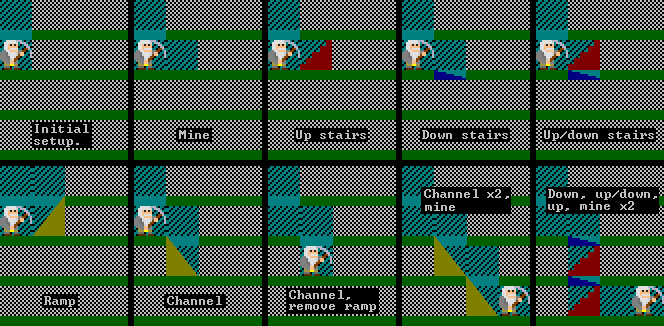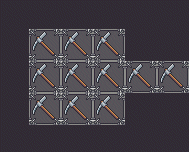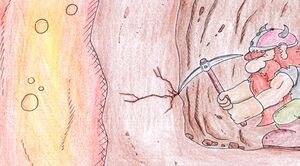- v50 information can now be added to pages in the main namespace. v0.47 information can still be found in the DF2014 namespace. See here for more details on the new versioning policy.
- Use this page to report any issues related to the migration.
Mining
| This article was migrated from DF2014:Mining and may be inaccurate for the current version of DF (v52.04). See this page for more information. |
| Mining |
|---|
| Skills used |
| Tasks |
v52.04 · v0.47.05 This article is about the current version of DF.Note that some content may still need to be updated. |
Mining is an essential part of building a fort in Dwarf Fortress. There are several reasons you might want to mine, such as searching for various stone types, ores and gems, or simply to create the basic tunnels and rooms in your fort. Mining refers to either the skill that performs mining, the labor associated with it, or simply the task or job of performing said labor. Military dwarves equipped with picks will use mining as their "weapon skill."
There are several types of jobs associated with this skill:
- Digging removes the section of the wall while preserving both the ceiling (which is the floor of the level above) and the floor.
- Channeling removes the section of the wall, the floor, and if possible places a ramp one level below.
- Ramps replaces the section with a ramp, also removing the tile and floor one level above.
- Stairs carves out upward and/or downward stairs.
- Remove Construction removes a construction, ie. a built wall, stair, floor, etc.
- Remove Stairs/Ramp removes a dug-out stairs or ramp.
Mining can only be done in pre-existing stone or soil. NOTE: Constructed walls, stairs or ramps are not dug and instead must be removed using the 'Remove Construction' option (m, x). This uses the mining skill to be completed. When discovering a unique stone, gem or ore, the game will display an annoucement that looks like the following:
You have struck saltpeter!
Understanding digging

Gray/black areas represent un-mined rock, cyan/black represents mined-out areas. Solid green represents existing floor "tiles", cyan represents mined-out floor tiles. Up stairs, down stairs, and ramps are red, blue, and mustard (yellow) respectively.
In each of the 9 "digging" scenarios, the dwarf miner is shown as having completed the command(s) listed in that figure, moving from left to right. Each individual command is separated by a comma ",". (The "x2" notation indicates that the command is completed twice.) The dwarf has completed those commands in the order they are listed. For example, in the bottom right figure: "Down stairs, up/down stairs, up stairs, mine x2" is five separate commands.
Each layer in the three-dimensional Dwarf Fortress map consists of two parts: a wall-part, and a floor-part. Mining a tunnel removes the wall-part but leaves the floor-part in place. Channeling removes the floor-part as well, leaving open space above, and if a wall-part exists below, it becomes an upward ramp. Digging an upward ramp removes the wall-part of the designated tile and both parts of the tile above it. Up stairs only modify the wall-part of the designated tile (and are unusable without Down stairs in the tile above), the Down stairs designation will remove the wall-part of the tile (if present) and place a stair connection in the floor-part of the designated tile. Up/down stairs modify both parts of the designated tile (but remain unusable until the tile above/below has the proper stair connection).
Making a dwarf a miner
- Go to the y labor menu, then work details tab
- Select the "Miners" work detail on the left side of the screen
- Find the dwarfs you would like to make a miner, and click the rightmost box, a green check mark should appear
- If you would like this dwarf to only mine, and ignore all other labors (they will still eat, sleep, take breaks, etc. ) you can toggle the dwarf's "Specialize" button (the hammer and lock icon) to be red.
To start mining, a miner requires an available pick. A dwarf's agility and mining skill affect how quickly they mine.
Giving a dwarf the miner work detail will effectively disable the "wood cutter" and "hunter" work details, as their associated labors all involve the usage of different tools.{{verfiy}
Designating the area to be mined
- Press m to bring up the Designations Menu.
- Highlight the requested action by pressing:
- m for mining
- u for channeling
- r for an upward ramp
- t for stairs, set a start and an end point in a different elevation to determine if it leads upwards or downwards
- (Optional) Set the priority with - and +. Tiles with first/lowest numbered priority value will be mined first.
- Move the cursor to the starting point, then press enter. You should see a green flashing cross symbol indicating that it's in Selection Mode.
- Move the cursor to another point to define the opposite corners of a rectangle, press enter again. A yellow area should now be highlighted, indicating the area to be mined. The opposite corner can also be placed on a different z-level with <>, designating areas across z-levels for mining. Tiles can also be designated by using the mouse and left-clicking.
Mineral production (profit!)
When the wall-part is removed from a stone tile, there is a 25% chance that a single stone (also known as a boulder) will be left behind. Minerals which are found in veins have a 33% chance of leaving ore, and minerals found in small clusters (or individual tiles) have a 100% chance of leaving a stone or rough gem behind. Finally, any "deep" material (i.e. adamantine or slade) has a 100% chance of leaving a usable stone (though the latter is normally undiggable). Mining skill only influences the amount of time it takes to mine each tile; it does not affect drop rate.
Carving a channel down or ramp up needs special care to provide the full 25%/33%/100% mineral production: in the case that both the bottom tile (where the new ramp up is) and the top tile (new open-space above the newly carved ramp) are both dug out together as part of the same designation, there is only a single chance of mineral production, even though two tiles had their wall-part removed, effectively halving the mineral production chance to 12.5%/16.5%/50% in that case. But if special care is taken to ensure the top open-space tile is dug out first before carving the ramp below it, the full chance from both tiles can be achieved.
The mason's workshop can create four blocks from each boulder, so on average you can create one stone block for each tile of stone mined. Each ore stone also produces 4 metal bars at a smelter, so, on average, you will produce 1⅓ bars of the basic metal* for every tile of ore mined, or 4/ for small clusters of rare ore.
- (* Two ores, tetrahedrite or galena, have a chance to produce additional bars of silver as well as producing the 4 bars of their basic metal (copper and lead, respectively). As a footnote, while iron ores produce 4 bars of iron, and that is all the metal required for 1 bar of steel, steel production additionally consumes 1 flux stone and 1 bar of fuel per single bar of steel produced.)
When tunnels are dug in soil, nothing is left from the material, there is no soil equivalent of a "stone" to be further used. The floor-part will remain (if it wasn't channeled), and is suitable for farming, or, if the right kind of soil, for sand or clay collection.
After pressing d, set the designation type with a to switch between designating all materials, designating just gems, designating just gems and ores, or designating ore/gem clusters or veins to be mined automatically. Switching the designation type to automining will allow you to quickly assign mining tasks to entire veins.
Training mining
Dwarves gain mining experience for each tile mined, be it stone, ore, gem, or soil. Soil is mined extremely quickly and is one of the fastest ways to train miners. Since the skill of mining also is used in combat, a dwarf with mining enabled that is carrying a pick will increase their mining skill through combat drills. This process is much faster than learning by digging through stone, but not nearly as fast as learning by digging through soil.
The fastest way to train mining is to first dig out upstairs, then remove the upstairs. Removing upstairs (even rock ones) is extremely quick and still provides mining experience.
Mining warm and damp stone
When designating any digging operation, warm and damp tiles will flash, indicating magma or water in adjacent tiles. Miners can dig these safely, provided there is an escape route. ("Safely" here implies only the short term survival of the digging dwarf, your fortress may well be flooded as a result, even many levels above the digging level, eventually killing your dwarf.)
Channeling and ramping designations involve two operations, and your dwarf will be submerged in the fluid when done. Unskilled swimmers can reach an exit ramp out of water if near enough, but magma will certainly cost your miner's life (the flow from either can knock dwarves off ledges, or, naturally, flood the fortress.)
Wall tiles above magma will flash "warm", and designations will be cancelled even if an entirely safe tunnel is being dug. This is rather annoying when carving out rooms above the magma sea, although there is a way around it. Designating a channel two levels above the magma will mine out the warm wall immediately above the magma, and the designation won't be cancelled because it's not in the area of the warm stone.
How to cancel a mining operation
If you placed a designated area for mining but want to cancel the mining (for example if you approached damp stone) simply go to Designations d and select Remove Designation x. Then select the starting point of the area you want to cancel with enter, move to the ending point and confirm again with enter.
Rampless channels
To create a channel with no ramps, you have to mine out the area underneath the channel first, or manually designate the ramps created for removal afterwards d -> z. If you wish for these channels to be completely inaccessible from the outside, channel out the access-point (downward staircase). Another (more complicated) way of removing any access to the moat is to replace the dug out ramps with constructed ones and creating a cave-in with constructed floors. Rampless channels are an effective substitute for walls against melee enemies that cannot fly, and they can be dug out far faster than a wall can be built. However, channels offer no defense against archers or dragonbreath.
When digging ramps upwards, watch out for loose stone or other items that might be on the floor above, as falling objects can injure the unfortunate miner.
See also
- Map tiles – Different types of walled, floor and open spaces.
- Caverns – Large underground tunnel systems.
- Exploratory mining – Mining focused on finding valuable stone.
- Soil – A list of soil types.
- Stone – A list of different types of stones and ores left behind from mining.
- Smoothing – Increase fortress value and dwarf happiness by improving the quality of your rough-stone mineshafts.
"Mining" in other Languages
|
| Mining | |
|---|---|
| Woodworking | |
| Stoneworking | |
| Hunting/Related | |
| Healthcare | |
| Farming/Related |
Butchery • Tanning • Farming (fields) • Dyeing • Gelding • Soap making • Wood burning • Potash making • Lye making • Milling • Brewing • Plant gathering • Plant processing • Cheese making • Milking • Shearing • Spinning • Cooking • Pressing • Beekeeping |
| Fishing/Related | |
| Metalsmithing | |
| Jewelry | |
| Crafts | |
| Engineering | |
| Hauling | |
| Other Jobs | |

